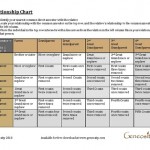The family relationship chart is used to provide a visual representation of the relationships between cousins and other family members. Second cousins, third cousins and once-removed relations are the most confusing. Understanding your genealogy can begin with learning how you’re related to others in your family tree.
Do you want to calculate a family relationship to a cousin or someone you share a great-grandparent with?
This is a great tool for genealogists and for anyone curious about how they are related to someone. A family relationship chart helps to trace family relationships and identify common ancestors. Identifying a common ancestor is the key! The first step is to identify your nearest common direct ancestor with a relative.
Keeping track of how you’re related to a relative can be somewhat confusing sometimes. Soon you’ll know the difference between first cousins, second cousins, third cousins, and what a cousin once removed means. We’ll also illustrate lots of blood relatives like great aunts and uncles and cousins as far out as four times removed!
Our Family Relationship Chart is provided in PDF format for easy, free download.
Genealogy Form – Family Relationship Chart for Download
Download Relationship Chart – PDF

Cousin Relationships and Relations To Other Blood Relatives
The general relationship rules are as follows:
First cousins are individuals that share a set of grandparents. Second cousins share a set of great-grandparents. Third cousins share a set of 2nd great grandparents (also called great-great-grandparents).
A cousin once removed descends from a common set of grandparents, yet is a generation ahead or behind yours. Notice on the family relationship chart that your first cousin’s children will be your first cousins once removed. Your great grandfather for instance might be a cousin’s grandfather. This makes them one generation removed from your position on the family tree.
Your full genetic siblings share the same relationship as you, to others in your family tree.
Half-siblings also share the same relationships as other extended family members as long as they are mutually blood-related. A half-brother will share in 50% of your lineage, as the pedigree of your common parent only.
Aunts and uncles are siblings of your parents. Great aunts and great uncles (properly called grand aunts and uncles) are the siblings of your grandparents.
Common Family Relationship Questions
Is it possible to have a cousin that is not related to you?
The rule of thumb in terms of a family relationship chart, is that you’re identifying others as being a blood relative. A blood relative means that you and another person share one or more common ancestors. A step-child or an adopted non-blood child (of any generation) that shares no genetic lineage as you, will be genetically un-related. However, family trees are more inclusive. Aunts and uncles married into the family are indeed related to you by marriage while you share no blood relationship with them. Consider that an in-law aunt or uncle related by marriage parented a child prior to their marriage to your relative (with a different partner). This child is of no relation genetically or on paper (via marriage) unless your blood relative adopts them. Often in the name of family inclusivity we still call them “cousins” regardless of their actual blood relation or not.
Read More: Who Gets Included in the Family Tree?
Is it possible to have an aunt or an uncle that is younger than you?
Absolutely! Big families tend to have elder nieces and nephews, and when the children of a family span a broad difference in age. Anyone of child-bearing age can birth an aunt or uncle if his/her parents are still having children themselves.
Is Uncle Grandpa something that can happen?
Sadly, yes. This rarely appears in genealogy but it has happened. It is possible for instance if one of your parents had an older male sibling that either by abuse or incest impregnated his own mother. The resulting child would be the half-brother or half-sister of their own sibling and father. When the resulting child has a family of their own, his/her children will have an Uncle Grandpa.
How can I calculate the family relationship with a really distant relative easily?
The main idea is that if you share a grandparent you’re first cousins. Shared great-grandparents make you a second cousin. 2nd great grandparents in common make you third cousins. This gets more complicated when you’re a generation removed or more, and the common ancestor is quite distant. A website called Famlii has a calculator here if you’re looking for an easier way to calculate your relationship to a distant relative.
Can an individual be related to you in more than one way?
Yes. In fact it is not too uncommon for ancestors to be related to you in more than one way. In genealogy we sometimes find parents or a married couple that were in fact distantly related though the individuals probably weren’t aware of it. Example: If your great grandfather married his third cousin once removed, his spouse would be your distant cousin and great-grandmother at the same time.
Conclusion: Finding out how you’re related to someone
The main takeaway in using a family relationship chart to calculate your relationship with relatives is that you focus on your nearest common ancestor. Your relationship with the common ancestor, compared with their relationship to the same person will define your relationship with that individual.
Relations spanning various generations are the determining factor in whether someone is a direct cousin or a generation-removed cousin. Many people confuse once-removed cousins with second cousins.
Use the family relationship chart as a visual representation of the various family relationships that exist within a family. These are typically organized in a hierarchical fashion, with the most immediate relationships at the top left of the chart and the more distant relationships spanning down and to the right.



